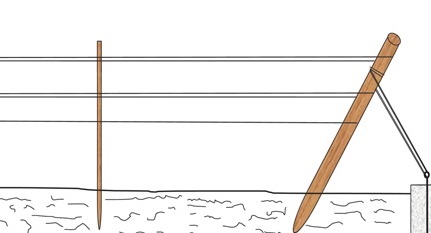Canopy Management
Trellising Systems

Trellising Systems and Training Systems refer to two different aspects of vineyard management.
Trellising provides the physical framework for the vine.
Training is how to manage the growth along that framework.
Trellising Systems
Trellising systems are crucial in viticulture because they help manage grapevine growth, improve fruit quality, and optimize vineyard management.
 |
 |
 |
| Vertical Shot | High Cordon | Umbrella Griffin |
By providing support and shaping the vine structure, they allow for better sunlight exposure, air circulation, and ease of harvesting:
Sunlight Exposure: Trellising systems are designed to maximize sunlight exposure to the vine's leaves and fruit, which is essential for photosynthesis, fruit ripening, and sugar production.
Air Circulation: Proper trellising improves airflow through the canopy, which reduces the risk of fungal diseases like powdery mildew and botrytis, especially in humid climates.
Yield Control: By controlling the vine’s structure, trellising helps manage the number of fruiting buds and overall yield.
Ease of Management: Trellises make it easier to prune, spray, pest control, and harvest the vines, both manually and mechanically.
Vine Vigor: In regions with vigorous vines, trellising systems help control excessive growth, which can otherwise lead to poor fruit quality and increased disease pressure.
Trellising Types
There are several trellising types used in vineyards, each with its unique advantages depending on factors like grape variety, climate, and vineyard management practices.
Vertical Systems
High Cordon. Vertical Shoot Positioning (VSP). Scott Henry. Smart Dyson.Spread Systems
T Trellis. Tatura (V Trellis)Horizontaly Systems
Geneva Double Curtain (GDC). Lyre. Pergola.Head Pruned Vines
Single Pole. Wagon Wheel. Head Training. Goblet.
High Cordon
High Cordon is a simple trellis with a single wire placed at a higher position, where the shoots grow downward. Grapevines are allowed to sprawl without much vertical training. It is often used for more vigorous varieties in hot climates or areas where low maintenance is important.

Advantages
- Minimal cost and maintenance
- Good for low to medium vigor vines
- Suitable for machine harvesting
VSP (Vertical Shoot Positioning)
The VSP system is the most widely used trellising system.
In this system, vines are trained to grow vertically with shoots directed upwards, usually supported by wires. Canes or spurs are tied horizontally to the lower wire, while shoots grow vertically.
VSP systems are popular in regions with moderate to cool climates, where controlling vigor and canopy management is important.

VSP Advantages
- Good sunlight exposure (less shade)
- Good airflow reduces the risk of disease
- Facilitates mechanical harvesting and pruning
- Compatible with both cane pruning and spur-pruning
Geneva Double Curtain (GDC)
The Geneva Double Curtain is a divided canopy system where two curtains of shoots grow downwards from two horizontal, high-positioned wires. The canopy is split, creating two vertical walls of foliage. It is suitable for vigorous vines as it helps manage excess growth.

GDC Advantages
- Increases sunlight penetration
- Increases air circulation
- Reduces shading and improves yield
- Effective in warmer regions with high vigor varieties
Lyre System
The Lyre system is a horizontally divided trellis where the canopy is split into two "arms" or sections, shaped like a U or lyre. It provides a wide canopy but controls shading by splitting the foliage, and is most suitable for highly vigorous vines, particularly in warmer climates where managing vigor is essential.

Lyre Advantages
- Excellent sunlight exposure
- Excellent air circulation
- Helps manage excessive vigor
- Reduces shading and improves fruit ripening.
- Increases yield potential
Watson

Pergola or Tendone
The Pergola (Italy: Tendone) is a horizontal trellis system where vines are trained across a large horizontal surface, like a roof. The grapes hang down beneath the canopy.
Pergola systems are common in Mediterranean climates and is traditional in Italy (Puglia and Sicily).

Pergola Advantages
- Prevents sunburn by providing shade to the fruit
- Provides good airflow
- Allows for high yields
Smart-Dyson (Ballerina System)
Smart-Dyson is a variation of VSP where shoots are trained both upward and downward, creating a split canopy. This increases sunlight exposure without increasing the overall height of the vine.

Smart-Dyson is ideal for regions with highly vigorous vines and where additional sunlight exposure can improve fruit ripeness, especially where a larger canopy surface area is needed for ripening.
Advantages
- Maximizes sunlight interception while maintaining a balanced canopy.
- Reduces shading and improves airflow.
- Increases the vine's productive surface area
- Manages high-vigor vines effectively. Reduces canopy density and the risk of disease
- Suitable for some mechanical vineyard operations
Scott Henry
The Scott Henry system involves a split canopy where half the shoots are trained upward and the other half are trained downward. This doubles the fruiting area without increasing row width.

The Scott Henry system is used for vigorous grape varieties in regions with ample sunlight. It is effective in cooler climates where ripening can be a challenge and where increased yield is desired without sacrificing quality.
Scott Henry Advantages
- Increases sunlight exposure and airflow
- Reduces shading within the canopy
- Increases yield
T Trellis
A T-top trellis consists of a vertical trunk and a horizontal crossbar at the top. The vine shoots are allowed to grow over the horizontal structure, creating a sprawling canopy similar to the pergola system.
It is common in areas where vine vigor is high and growers want to maximize yield while protecting the fruit from heat and excessive sunligh.
Advantages
- Provides excellent support for heavy grape clusters
- Simplifies mechanical harvesting and pruning
- Provides good shading for grapes in hot climates
- A high fruiting zone reduces the risk of diseases from soil contact
Tatura Trellis
The Tatura Trellis is a V-shaped system where the canopy is divided into two sloping planes. This allows the shoots to spread outward in two directions.
Advantages
- Provides good sunlight penetration and air circulation
- Provides good sunlight penetration and air circulation
Illustration of Trellising Systems
